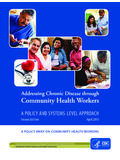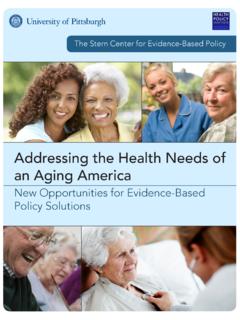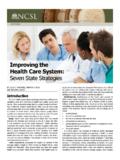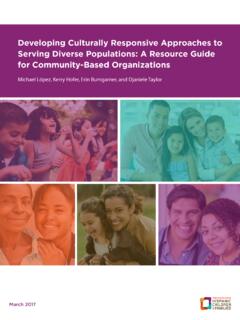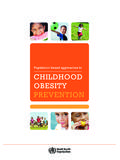Transcription of Best Practice Approaches for State, Community and ...
1 Best Practice Approach: Teledentistry: Opportunities for Expanding the Capacity and Reach of the Oral Healthcare System 1 A Best Practice Approach Report describes a public health strategy, assesses the strength of evidence on the effectiveness of the strategy, and uses Practice examples to illustrate successful/innovative implementation. Date of Report: December 2021 Executive 1 Background and Rationale .. 2 Guidelines and Recommendations .. 4 Best Practice Criteria .. 8 Research Evidence .. 9 State Practice Examples .. 11 Acknowledgements .. 14 References .. 14 Executive Summary Teledentistry is a tool that has been used for several decades with the potential to transform oral healthcare delivery. It can improve oral health by helping to reduce known barriers that have kept people from accessing oral health care, such as cost, time, distance, and availability of providers.
2 The Association of State and Territorial Dental Directors (ASTDD) encourages state/territorial oral health programs and stakeholders to identify Community barriers to care and consider teledentistry as part of the solution. Oral health stakeholders should work with local and state agencies to develop policies and reimbursement mechanisms that will support the long term and sustained use of teledentistry. Stakeholders should also ensure that teledentistry training for patients and providers is available so that oral healthcare systems can effectively utilize it. Best Practice Approaches for State, Community and Territorial Oral health Programs 2021 Best Practice Approach Teledentistry: Opportunities for Expanding the Capacity and Reach of the Oral Healthcare System Best Practice Approach: Teledentistry: Opportunities for Expanding the Capacity and Reach of the Oral Healthcare System 2 Background and Rationale Introduction As a component of the broader telehealth system, teledentistry serves an important role in reducing barriers that communities and populations face when seeking oral healthcare.
3 Increasing interest in using teledentistry as a tool to connect patients to their oral health provider when they are not in the same location has growing support from a variety of organizations, including organized dentistry and payors.* This Best Practices Approach Report (BPAR) will serve as a framework for states and territories to identify opportunities and strategies for how to incorporate teledentistry into their overall oral health delivery systems. 1-5 Why Teledentistry? Historically, the dental office has been the center of oral healthcare. However, over the years, numerous oral health initiatives have expanded the reach of the dental office in ways that have improved the oral health of communities and populations across the United states (US).
4 Community water fluoridation, school-based sealant programs, integrated medical-dental programs, portable dental programs, and expansion of the oral health workforce have positively impacted oral health and will continue to do so into the Over the last few decades, the percentage of people receiving care in dental offices has increased across age and ethnic Even with these improvements, the majority of the US population still does not receive regular dental care. Many populations continue to face significant barriers to receiving care in the dental office, particularly those from medically underserved urban or rural areas often populated by people of color and ethnic minorities, as well as seniors and individuals with disabilities who are not able to travel to a dental office.
5 Among the barriers to accessing dental care in office settings, many working-age adults and non-working seniors avoid dental care because of its high cost, the dentist is too far away, they do not have time to go to a dentist, or they cannot find a dentist that accepts their ,13 To address the health inequities that have resulted from irregular or no care, many people can use teledentistry-enabled oral health systems. Teledentistry is a crucial modification that brings oral health services to those facing significant barriers to receiving care in dental offices. Due in part to advances in technology (including the internet, electronic health records, and digital imaging), teledentistry increases access, allowing oral health professionals to reach patients in their local communities.
6 What is Teledentistry? Teledentistry can be categorized in primarily two ways. One way is based on the use of technology. The American Dental Association (ADA) has adopted health industry standard *American Dental Association, American Student Dental Association, American Dental Education Association, National Network for Oral health Access, American Academy of Pediatric Dentistry, CareQuest Institute of Oral health , Delta Dental and DentaQuest Teledentistry has the potential to be part of a paradigm shift in healthcare delivery that can play a key role in mitigating barriers and improving health for populations with traditionally poor access to dental care and oral health services. ASTDD White Paper, Teledentistry: How Technology Can Facilitate Access to Care Best Practice Approach: Teledentistry: Opportunities for Expanding the Capacity and Reach of the Oral Healthcare System 3 definitions based on the technology (asynchronous, synchronous, remote patient monitoring, and mobile health ), so it is not necessary to repeat those definitions The second way to categorize teledentistry is by the situation in which it is used.
7 This can include patient-to-provider transfer of images, provider-to-provider consultation, pre- and post-visit interactions, limited Community interventions, and full-service Community systems where the objective is to keep people healthy in the Community site and use a dental office only for procedures that cannot be completed in the Community . Employing technology to connect patients to an oral health provider is the foundation of teledentistry, whether the patient faces barriers to accessing care in a dental office or when it is not necessary for a patient to be physically ,13 While the use of teledentistry lags behind that of telemedicine, there have been several demonstrations of its power as a tool to connect patients with providers at a distance.
8 It allows providers to work more efficiently. Here are a few examples from a broad range of uses: In the mid-1990s, the first demonstration of teledentistry within the Department of Defense indicated that increasing access to specialists resulted in improved decision making and better communication between providers and The Virtual Dental Home model developed by Dr. Paul Glassman demonstrated how two-thirds of school aged children could be managed successfully by a dental hygienist in a Community location collaborating with a remote dentist in a dental In Brazil, the need for general dentists to send patients for specialist evaluation dropped by 36% after a teledentistry consultation with oral medicine Video consultations, for the purposes of postoperative evaluations, oral hygiene instruction, tobacco or nutritional counseling, or emergency triaging, eliminate the need to use personal protective equipment and are appreciated by patients, who sometimes prefer this method as compared to traditional, in-person visits.
9 Particularly during the COVID-19 These examples illustrate how teledentistry can be used and provide insight into the tremendous diversity it offers, as well as demonstrate how it supports the goals of the Triple Improved patient care coordination, getting patients into the oral healthcare system, greater access to dental specialists, decreased costs for the dental clinic, and increased patient satisfaction are just a few benefits that teledentistry provides to the oral healthcare system, and more importantly to the A Pathway to Widespread Teledentistry As more states and territories develop policies and regulations around teledentistry, it is important to keep key issues in mind. To foster improvements in oral health , consider adopting policies that support the full range of technologies that can facilitate remote communications.
10 For example, states such as California allow for both synchronous and asynchronous forms of teledentistry; but other states , such as Ohio, define it as synchronous only, prohibiting the use of asynchronous ,23 These limiting policies impede individuals developing teledentistry models to address disparities in health care. Given that almost 15 million people do not have access to broadband internet and more than 120 million do not use internet at broadband speeds (meaning they have access to it, but are not using it) this creates a serious concern when these types of blanket policies are Along with developing widely encompassing state policies, federal policies, such as the Federal Communications Synchronous teledentistry is a real-time interaction between a dental provider and a patient an asynchronous teledentistry is when patient data is submitted to the dental provider who will review that data later.


